Types of Skin Rashes and How to Treat Them
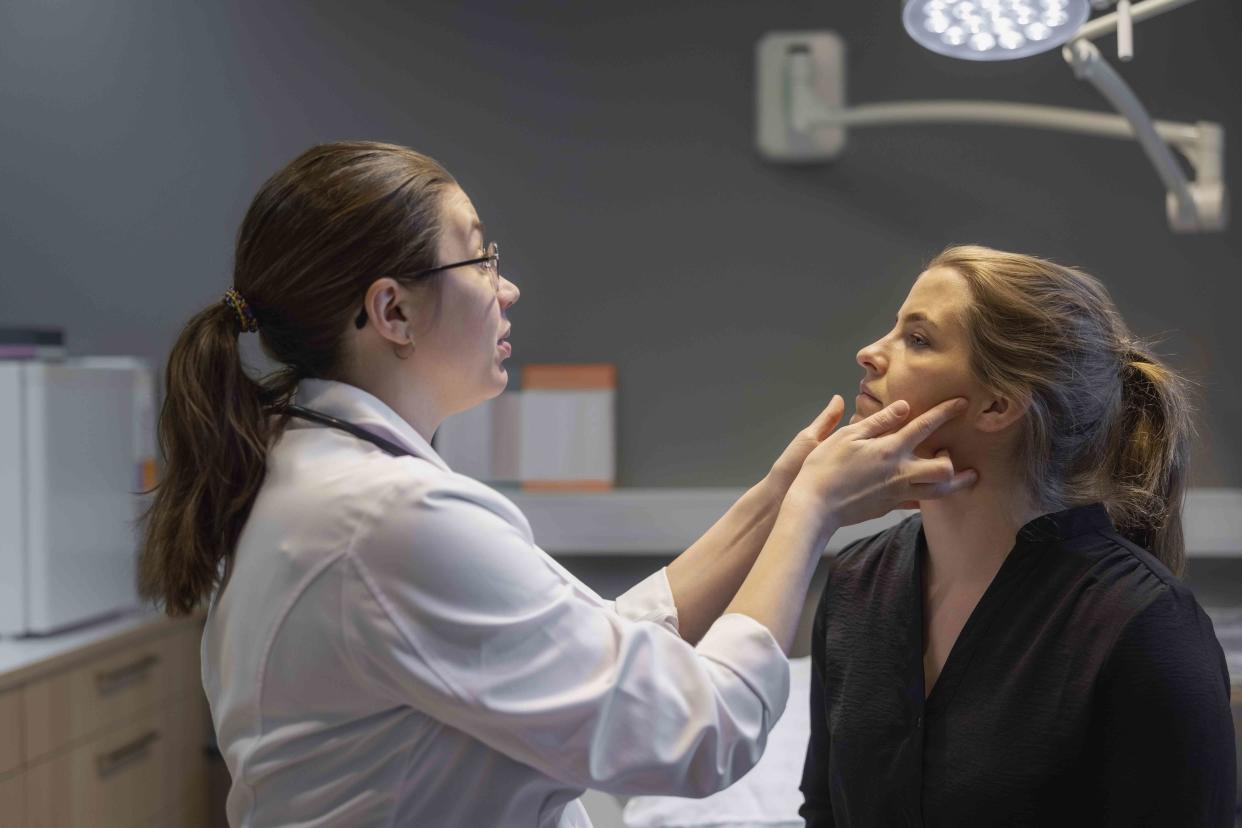
Portra / Getty Images
Medically reviewed by Susan Bard, MD
A skin rash is generally defined as an area of irritated skin, noted by a change in texture, color, or feeling—for example, itchiness. It can happen due to a variety of different causes. Symptoms might include discoloration, itchiness, pain, swelling, blistering, and flaky or bumpy skin.
Possible causes of a skin rash include allergies, irritating substances, medications, infections, and as a side effect of many medical conditions. Treatment depends on the cause and might include topical medication (applied to your skin) or oral medication (taken by mouth) as well as lifestyle shifts.
Causes
Skin rash causes fall under several general categories, including:
Dermatitis (a general term used to describe skin inflammation)
Allergies
Insect bites
Medical conditions
Each general category includes different types of skin rashes with particular causes and symptoms.
Skin Rash Types
Common types of skin rashes include dermatitis, psoriasis, hives, insect bites, and shingles.
Eczema
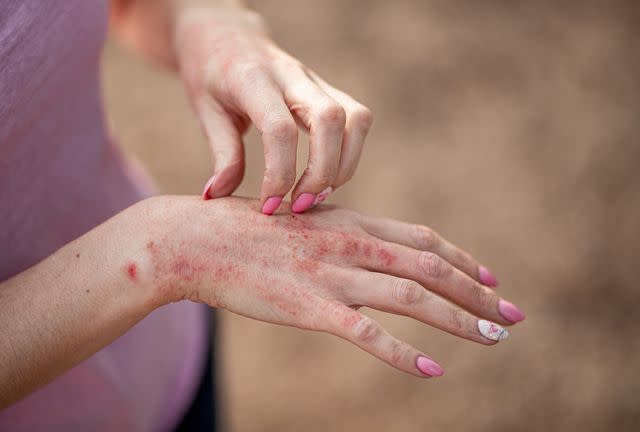
Irina Esau / Getty Images
Eczema, also known as dermatitis, is a term for different types of swollen skin rashes. These commonly form on the face, hands, feet, and behind the knees. The rash may look discolored or red and will be dry, itchy, and swollen.
You might have eczema for a short period of time, or it might be more chronic (long-term). It's not contagious, but the exact cause is unclear. It's likely due to genetic and environmental factors. For example, it's associated with hay fever (an allergic reaction to pollen) and asthma (a chronic condition that affects the airways in your lungs).
Common types of eczema include atopic dermatitis, allergic contact dermatitis, irritant contact dermatitis, and seborrheic dermatitis.
Atopic Dermatitis
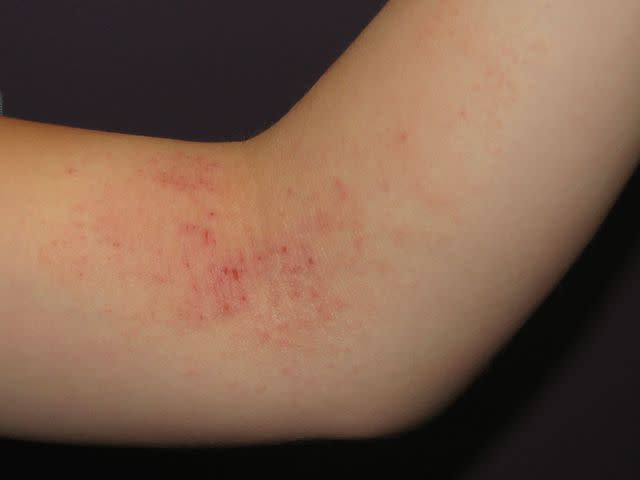
Courtesy of Dermnet
Atopic dermatitis is a type of chronic eczema. It's more common in infants and children, as well as in people who have seasonal allergies or asthma. It also tends to run in families.
Atopic dermatitis can cause rashes anywhere on the skin, including your face. People with atopic dermatitis have more sensitive skin, possibly due to bacteria on their skin that causes an immune response.
Triggers of atopic dermatitis include:
Allergies
Illness
Dry skin
Sudden changes in temperature
Perfumes and dyes
Allergic Contact Dermatitis

Courtesy of Dermnet
Allergic contact dermatitis happens when your skin comes into contact with an allergen that causes an immune reaction.
Common triggers include:
Nickel
Latex
Fragrances found in perfume, cosmetics, and hair products
Within a day or two of exposure, you might notice signs such as:
Severe itchiness
Streaky discoloration on and around the rash
Swelling
Blisters
Flakiness
The allergy develops with repeated exposure over time, and you might not experience a reaction for years. The allergy might remain for the rest of your life. Symptoms might remain for weeks after exposure to the trigger.
Irritant Contact Dermatitis
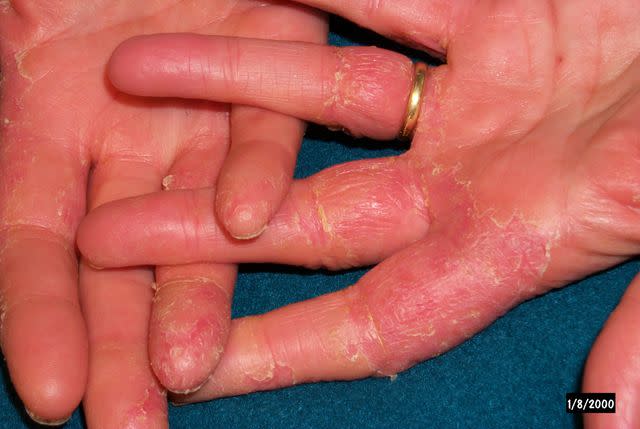
Courtesy of Dermnet
Irritant contact dermatitis is more common than allergic contact dermatitis. This type of rash develops when there’s direct contact with a substance that “damages” your skin through irritation or friction.
Some of the most common chemicals to prompt this type of rash include:
Household cleaning products and soaps
Pesticides
Cement
Hair dyes
Irritant contact dermatitis might feel painful rather than itchy. The reaction can show up after either a short period of contact or through repeated exposure.
Seborrheic Dermatitis
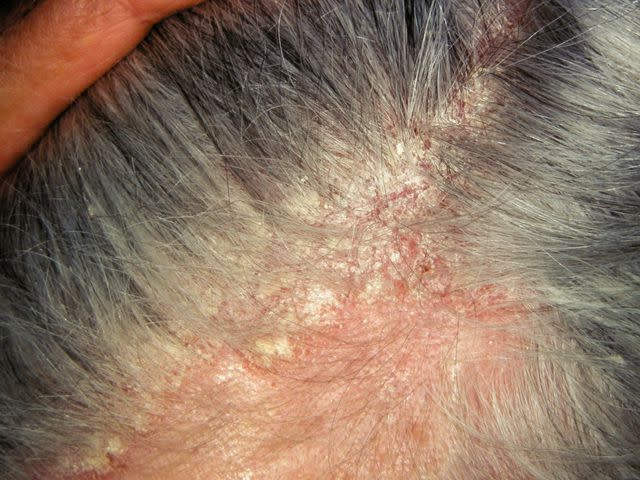
Courtesy of Dermnet
Seborrheic dermatitis is a type of atopic dermatitis. It appears in areas with many sebaceous glands, including the face, scalp, and chest. Sebaceous glands are glands in hair follicles that produce sebum, an oily substance that provides moisture to your skin.
Symptoms of seborrheic dermatitis usually appear gradually and include:
Itchiness
Dandruff (on the scalp)
Greasy yellow scaling
The cause is unknown, but it may be a reaction to yeasts on the skin.
Related: Scalp Psoriasis vs. Dandruff
Hives
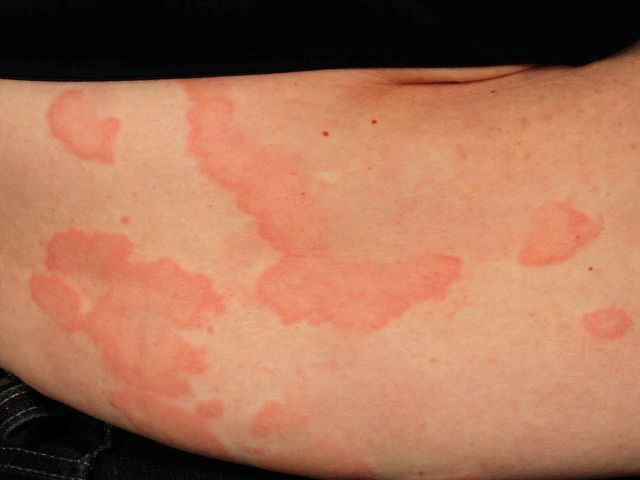
Courtesy of Dermnet
Hives (urticaria) are raised welts that form on a patch of skin. Symptoms include significant itching and swelling.
Hives often develop as a result of a food or drug allergy, but they have many other potential causes. Possible triggers include:
Illness
Infection
Insect bites
Water exposure
Stress
Hives typically last less than six weeks, though some cases can last longer.
Psoriasis
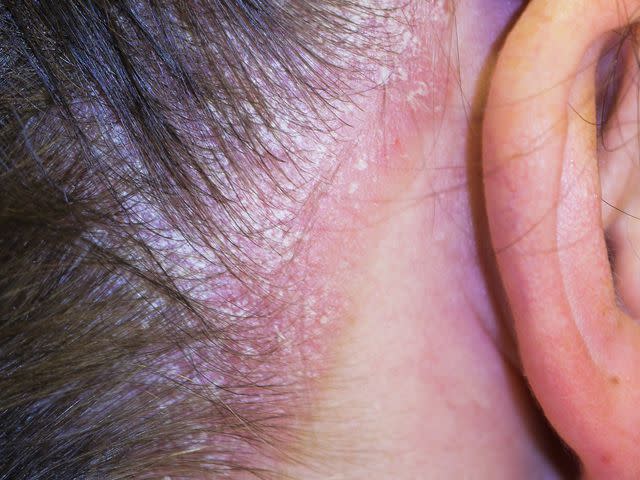
Courtesy of Dermnet
Psoriasis is a skin condition characterized by thick, scaly, and often red or discolored skin rash on certain parts of your body—including elbows, knees, and scalp. Irritation and itchiness are common symptoms. Most people have plaque psoriasis, which is characterized by silvery-white flaky scales on top of the rash.
Certain triggers may prompt the rash to flare up, including:
Infections
Dry air
Skin injury
Medications
Stress
Sunlight
Most people develop psoriasis between the age of 15 and 35. It isn't contagious, but researchers speculate that there is a genetic component.
Insect Bites
It’s common to experience skin irritation after being bitten or stung by a bug. While many bites are harmless and limited to a small bump or two, certain bug bites can be serious—particularly if you’re allergic to a bug’s venom or if the bug is carrying a disease.
For example, a tick bite can prompt a red or discolored rash that’s shaped like a target. This might signal Lyme disease, which requires medical treatment as soon as possible.
On the other hand, flea bites can manifest as small, itchy, painful clusters of bumps that usually appear on the lower part of the leg. While these bites can be bothersome, they generally resolve on their own with no complications.
Related: 10 Types of Bug Bites and How To Treat Them
Shingles
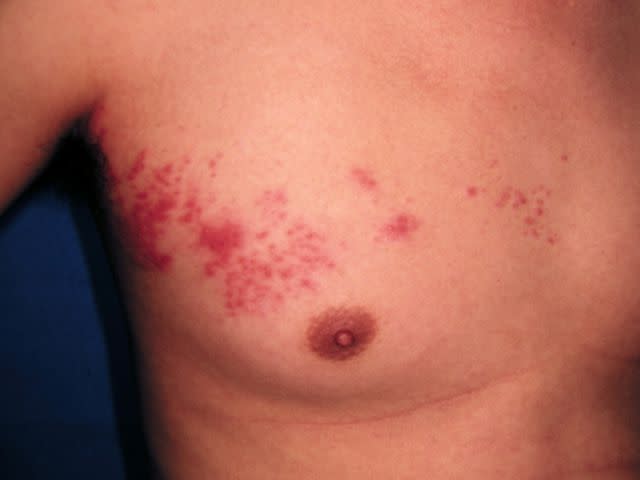
Courtesy of Dermnet
A previous case of chickenpox or varicella vaccination can trigger shingles (herpes zoster). The varicella-zoster virus, which causes chickenpox, stays dormant in your body and can manifest as shingles years later.
Shingles causes a painful, burning rash that appears in clusters of small blisters, often on your torso. You may notice a tingling sensation a few days before the rash appears. The blisters may crack open and bleed as they heal, which usually happens within several weeks.
Shingles may also include symptoms like fever, chills, headache, joint pain, and a general feeling of being unwell. These symptoms usually resolve as the rash heals. Treatment is most effective when started within the first few days you experience symptoms.
Common Skin Rashes in Children
Common causes of skin rashes in children include:
Atopic dermatitis: This condition affects about 20% of children in the United States. It's more common in infants and children than adults.
Seborrheic dermatitis: This type of dermatitis is known as cradle cap in infants and young children.
Diaper rash: Diaper rash is often caused by prolonged exposure to a damp or wet diaper. It may be accompanied by a candidal infection (fungal infection caused by yeast).
Impetigo: This is a bacterial infection characterized by small fluid-filled bumps with a thick, yellow crust.
Viral exanthem: This type of rash is usually related to a viral infection like chickenpox and measles.
It's important to recognize any other symptoms that accompany a rash in children when making a diagnosis. For example, pruritus (itchy skin) might be a sign of atopic dermatitis or erythema infectiosum (fifth disease). Erythema infectiosum is a viral infection that can cause a bright red rash on the cheeks, as well as on the torso and limbs. It can also cause a fever. Roseola is another viral infection that can cause a rash and fever.
Skin Rash Treatment
Skin rashes are usually treated by a dermatologist, a doctor who specializes in skin, hair, and nail health. The exact treatment for a rash will depend on its specific cause.
A dermatologist may prescribe one or more of the following options as part of a treatment plan:
Over-the-counter (OTC) oral antihistamines: Medications often used to treat allergies can help reduce swelling and itching.
Topical corticosteroids: Medications that reduce inflammation are often used to treat eczema.
Topical or systemic immunomodulators: Medications like Protopic (tacrolimus), Opzelura (ruxolitinib), Dupixent (dupilumab) can suppress the skin's immune response.
Prescription antiviral medications: Medications like Zovirax (acyclovir), Valtrex (valacyclovir), and Famvir (famciclovir) can help treat shingles.
At-home remedies: Topical remedies like calamine lotion, cool compresses, or oatmeal baths can soothe itchiness.
Avoiding the trigger: Learning what triggers the rash and avoiding those triggers can help prevent an allergic or irritant-related rash.
While it may be difficult, try to avoid scratching. Scratching a rash worsens symptoms and can lead to additional irritation or infection.
When to Visit a Healthcare Provider
Although most rashes are not life-threatening, some rashes can signal something more serious.
If you have a rash and notice any of the following symptoms, see a dermatologist or go to the emergency room immediately:
A rash that covers your body: This could be a sign of an infection or allergic reaction.
A rash that appears suddenly and spreads quickly: This rash might be due to an allergy to a medication or other substance.
A blistering rash: Any blisters that turn into open sores can be the result of an allergic reaction or another medical condition. They can be particularly problematic if they affect the skin around your mouth, eyes, or genitals.
A rash that is painful or appears infected: Symptoms of infection include swelling, crusting, warmth, and potentially yellow or green fluid (pus).
A rash accompanied by fever: This likely indicates an infection like measles, shingles, mononucleosis, or scarlet fever.
A rash accompanied by difficulty breathing or swelling in the mouth or throat: This may be an allergic reaction or anaphylaxis (a severe reaction, potentially life-threatening allergic reaction).
Some rashes might take days or perhaps weeks to heal, but always reach out to a healthcare provider if your rash isn't improving after a week or so. Reach out sooner if it appears to be infected or getting worse.
A Quick Review
Rashes are patches of skin that are abnormal in color or texture. They can look bumpy, scaly, or swollen, and they're usually itchy or painful. Many things can trigger a rash, including allergies, infections, bug bites, or medical conditions.
You can treat many rashes at home with OTC medications and soothing skin care, but keep an eye on them. Reach out to a healthcare provider if the rash is painful or getting worse, and seek immediate medical attention if your rash spreads quickly or shows possible signs of infection, or if you experience other symptoms like a fever.
For more Health news, make sure to sign up for our newsletter!
Read the original article on Health.

